12.2: The American Family
- Page ID
- 3432
\( \newcommand{\vecs}[1]{\overset { \scriptstyle \rightharpoonup} {\mathbf{#1}} } \)
\( \newcommand{\vecd}[1]{\overset{-\!-\!\rightharpoonup}{\vphantom{a}\smash {#1}}} \)
\( \newcommand{\id}{\mathrm{id}}\) \( \newcommand{\Span}{\mathrm{span}}\)
( \newcommand{\kernel}{\mathrm{null}\,}\) \( \newcommand{\range}{\mathrm{range}\,}\)
\( \newcommand{\RealPart}{\mathrm{Re}}\) \( \newcommand{\ImaginaryPart}{\mathrm{Im}}\)
\( \newcommand{\Argument}{\mathrm{Arg}}\) \( \newcommand{\norm}[1]{\| #1 \|}\)
\( \newcommand{\inner}[2]{\langle #1, #2 \rangle}\)
\( \newcommand{\Span}{\mathrm{span}}\)
\( \newcommand{\id}{\mathrm{id}}\)
\( \newcommand{\Span}{\mathrm{span}}\)
\( \newcommand{\kernel}{\mathrm{null}\,}\)
\( \newcommand{\range}{\mathrm{range}\,}\)
\( \newcommand{\RealPart}{\mathrm{Re}}\)
\( \newcommand{\ImaginaryPart}{\mathrm{Im}}\)
\( \newcommand{\Argument}{\mathrm{Arg}}\)
\( \newcommand{\norm}[1]{\| #1 \|}\)
\( \newcommand{\inner}[2]{\langle #1, #2 \rangle}\)
\( \newcommand{\Span}{\mathrm{span}}\) \( \newcommand{\AA}{\unicode[.8,0]{x212B}}\)
\( \newcommand{\vectorA}[1]{\vec{#1}} % arrow\)
\( \newcommand{\vectorAt}[1]{\vec{\text{#1}}} % arrow\)
\( \newcommand{\vectorB}[1]{\overset { \scriptstyle \rightharpoonup} {\mathbf{#1}} } \)
\( \newcommand{\vectorC}[1]{\textbf{#1}} \)
\( \newcommand{\vectorD}[1]{\overrightarrow{#1}} \)
\( \newcommand{\vectorDt}[1]{\overrightarrow{\text{#1}}} \)
\( \newcommand{\vectE}[1]{\overset{-\!-\!\rightharpoonup}{\vphantom{a}\smash{\mathbf {#1}}}} \)
\( \newcommand{\vecs}[1]{\overset { \scriptstyle \rightharpoonup} {\mathbf{#1}} } \)
\( \newcommand{\vecd}[1]{\overset{-\!-\!\rightharpoonup}{\vphantom{a}\smash {#1}}} \)
\(\newcommand{\avec}{\mathbf a}\) \(\newcommand{\bvec}{\mathbf b}\) \(\newcommand{\cvec}{\mathbf c}\) \(\newcommand{\dvec}{\mathbf d}\) \(\newcommand{\dtil}{\widetilde{\mathbf d}}\) \(\newcommand{\evec}{\mathbf e}\) \(\newcommand{\fvec}{\mathbf f}\) \(\newcommand{\nvec}{\mathbf n}\) \(\newcommand{\pvec}{\mathbf p}\) \(\newcommand{\qvec}{\mathbf q}\) \(\newcommand{\svec}{\mathbf s}\) \(\newcommand{\tvec}{\mathbf t}\) \(\newcommand{\uvec}{\mathbf u}\) \(\newcommand{\vvec}{\mathbf v}\) \(\newcommand{\wvec}{\mathbf w}\) \(\newcommand{\xvec}{\mathbf x}\) \(\newcommand{\yvec}{\mathbf y}\) \(\newcommand{\zvec}{\mathbf z}\) \(\newcommand{\rvec}{\mathbf r}\) \(\newcommand{\mvec}{\mathbf m}\) \(\newcommand{\zerovec}{\mathbf 0}\) \(\newcommand{\onevec}{\mathbf 1}\) \(\newcommand{\real}{\mathbb R}\) \(\newcommand{\twovec}[2]{\left[\begin{array}{r}#1 \\ #2 \end{array}\right]}\) \(\newcommand{\ctwovec}[2]{\left[\begin{array}{c}#1 \\ #2 \end{array}\right]}\) \(\newcommand{\threevec}[3]{\left[\begin{array}{r}#1 \\ #2 \\ #3 \end{array}\right]}\) \(\newcommand{\cthreevec}[3]{\left[\begin{array}{c}#1 \\ #2 \\ #3 \end{array}\right]}\) \(\newcommand{\fourvec}[4]{\left[\begin{array}{r}#1 \\ #2 \\ #3 \\ #4 \end{array}\right]}\) \(\newcommand{\cfourvec}[4]{\left[\begin{array}{c}#1 \\ #2 \\ #3 \\ #4 \end{array}\right]}\) \(\newcommand{\fivevec}[5]{\left[\begin{array}{r}#1 \\ #2 \\ #3 \\ #4 \\ #5 \\ \end{array}\right]}\) \(\newcommand{\cfivevec}[5]{\left[\begin{array}{c}#1 \\ #2 \\ #3 \\ #4 \\ #5 \\ \end{array}\right]}\) \(\newcommand{\mattwo}[4]{\left[\begin{array}{rr}#1 \amp #2 \\ #3 \amp #4 \\ \end{array}\right]}\) \(\newcommand{\laspan}[1]{\text{Span}\{#1\}}\) \(\newcommand{\bcal}{\cal B}\) \(\newcommand{\ccal}{\cal C}\) \(\newcommand{\scal}{\cal S}\) \(\newcommand{\wcal}{\cal W}\) \(\newcommand{\ecal}{\cal E}\) \(\newcommand{\coords}[2]{\left\{#1\right\}_{#2}}\) \(\newcommand{\gray}[1]{\color{gray}{#1}}\) \(\newcommand{\lgray}[1]{\color{lightgray}{#1}}\) \(\newcommand{\rank}{\operatorname{rank}}\) \(\newcommand{\row}{\text{Row}}\) \(\newcommand{\col}{\text{Col}}\) \(\renewcommand{\row}{\text{Row}}\) \(\newcommand{\nul}{\text{Nul}}\) \(\newcommand{\var}{\text{Var}}\) \(\newcommand{\corr}{\text{corr}}\) \(\newcommand{\len}[1]{\left|#1\right|}\) \(\newcommand{\bbar}{\overline{\bvec}}\) \(\newcommand{\bhat}{\widehat{\bvec}}\) \(\newcommand{\bperp}{\bvec^\perp}\) \(\newcommand{\xhat}{\widehat{\xvec}}\) \(\newcommand{\vhat}{\widehat{\vvec}}\) \(\newcommand{\uhat}{\widehat{\uvec}}\) \(\newcommand{\what}{\widehat{\wvec}}\) \(\newcommand{\Sighat}{\widehat{\Sigma}}\) \(\newcommand{\lt}{<}\) \(\newcommand{\gt}{>}\) \(\newcommand{\amp}{&}\) \(\definecolor{fillinmathshade}{gray}{0.9}\)Objectives
- Explain how American families begin and describe some of the disruptions they might encounter.
- Analyze some of the trends in American family life currently being examined by sociologists.
- Analyze how courtship and marriage have changed.
- Explain some of the trends in American family life.
Universal Generalizations
- Most families in America begin with marriage.
- In the U.S., the basis for most marriages is romantic love.
- Most Americans marry people with similar characteristics: people who are close to them in age and within their own socioeconomic class.
- Family violence is the most devastating of family disruptions.
- In America, one of the most common of family disruptions is divorce.
- Empty nests and family dissolution are other disruptions to the American family structure.
- How have trends in family life such as delayed marriage or remarriage changed the United States?
Guiding Questions
- Why do people marry?
- How do families help each other survive?
- How have courtship and marriage changed?
- Why do some people marry someone with similar characteristics?
- What role does family violence play in the disruption of the family?
- What economic effects does divorce have on former partners?
Family Patterns in the United States
Using U.S. census data (U.S. Census Bureau, 2010),U.S. Census Bureau. (2010). Statistical abstract of the United States: 2010. Washington, DC: U.S. Government Printing Office. Retrieved from www.census.gov/compendia/statab we first sketch the major types of family arrangements that now exist.

Marriage
The census defines a household as being all the people who live together in a dwelling unit, whether or not they are related by blood, marriage, or adoption. About 117 million households exist in the United States. Of this number, about 67% are family households and 33% are nonfamily households. Most of the non-family households consist of only one person. About half of all households involve a married couple, and half do not involve a married couple.
Americans believe that love is the main foundation of marriage. Most who never have been married say they would like to be at some point in their lives. However, statistics show Americans aren’t rushing to the altar, and the U.S. marriage rate is at an all-time low—only 51% of adults were married in 2011, according to U.S. Census Bureau statistics.
The romantic ideal of marriage plays out in survey data that show whether they are married or not, Americans are more inclined to choose “love” as a reason for marriage than any other factor. In a 2010 Pew Research Center survey, love wins out over “making a lifelong commitment,” as well as “companionship,” “having children,” and “financial stability” as a very important reason to wed.
Among married people, 93% say love is a very important reason to get married; 84% of unmarried people say so. Men and women are equally likely to say love is a very important reason to get married.
This last figure should not suggest that marriage is unimportant. Only 26% of all adults (18 or older) have never been married, about 57% are currently married, 10% are divorced, and 6% are widowed (see Figure 12.2.2 "Marital Status of the U.S. Population, 2008, Persons 18 Years of Age or Older"). Because more than half of the never-married people are under 30, it is fair to say that many of them will be getting married sometime in the future. When we look just at people aged 45–54, about 88% are currently married or had been married at some point in their lives. These figures all indicate that marriage remains an important ideal in American life, even if not all marriages succeed.
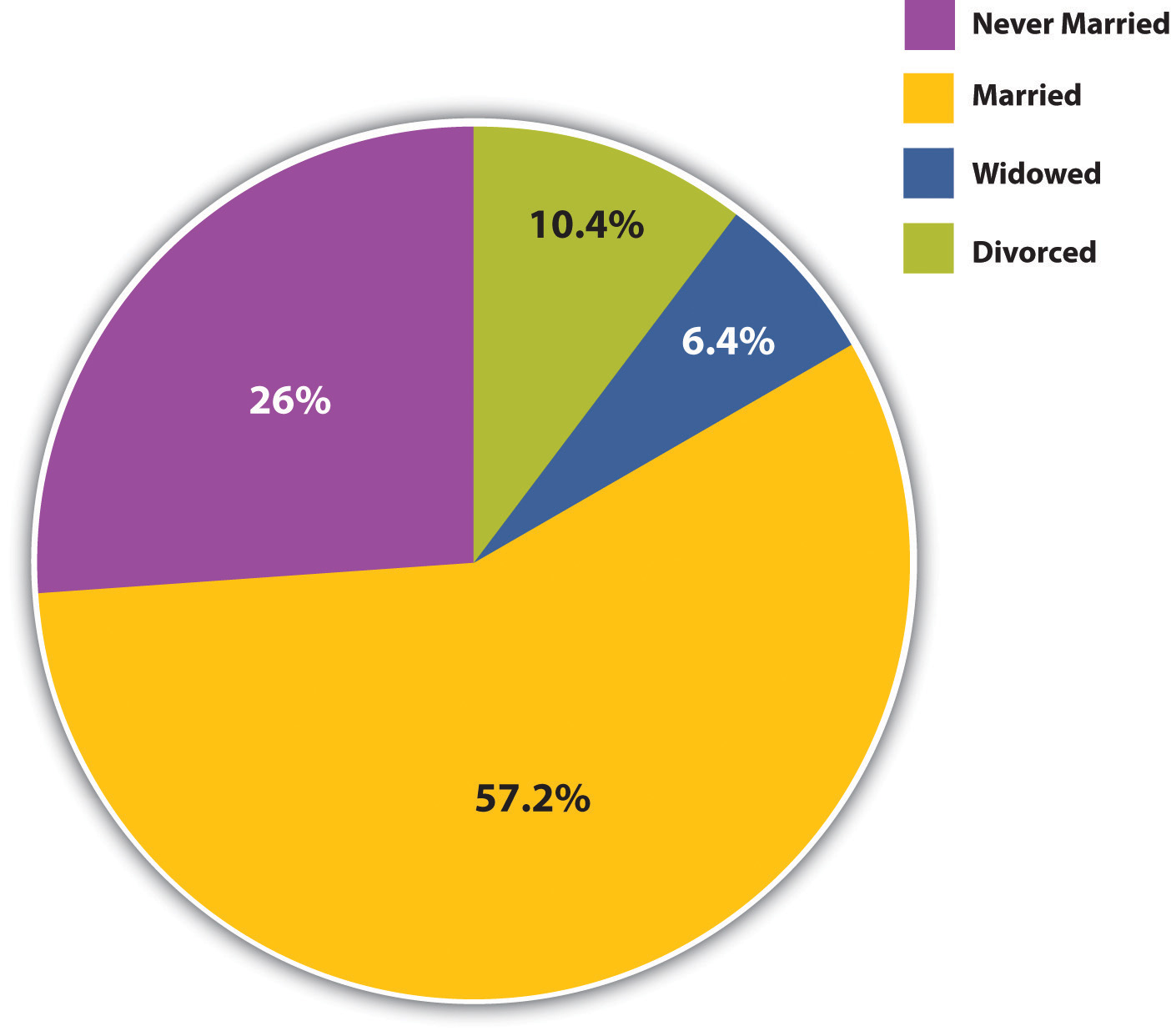
It is interesting to see how the age at which people first get married has changed. Figure 12.2.3 "Median Age at First Marriage for Men and Women, 1890–2009" shows that age at first marriage declined gradually during the first half of the 20th century, before dropping more sharply between 1940 and 1950 because of World War II. It then rose after 1970 and today stands at almost 28 years for men and 26 years for women.
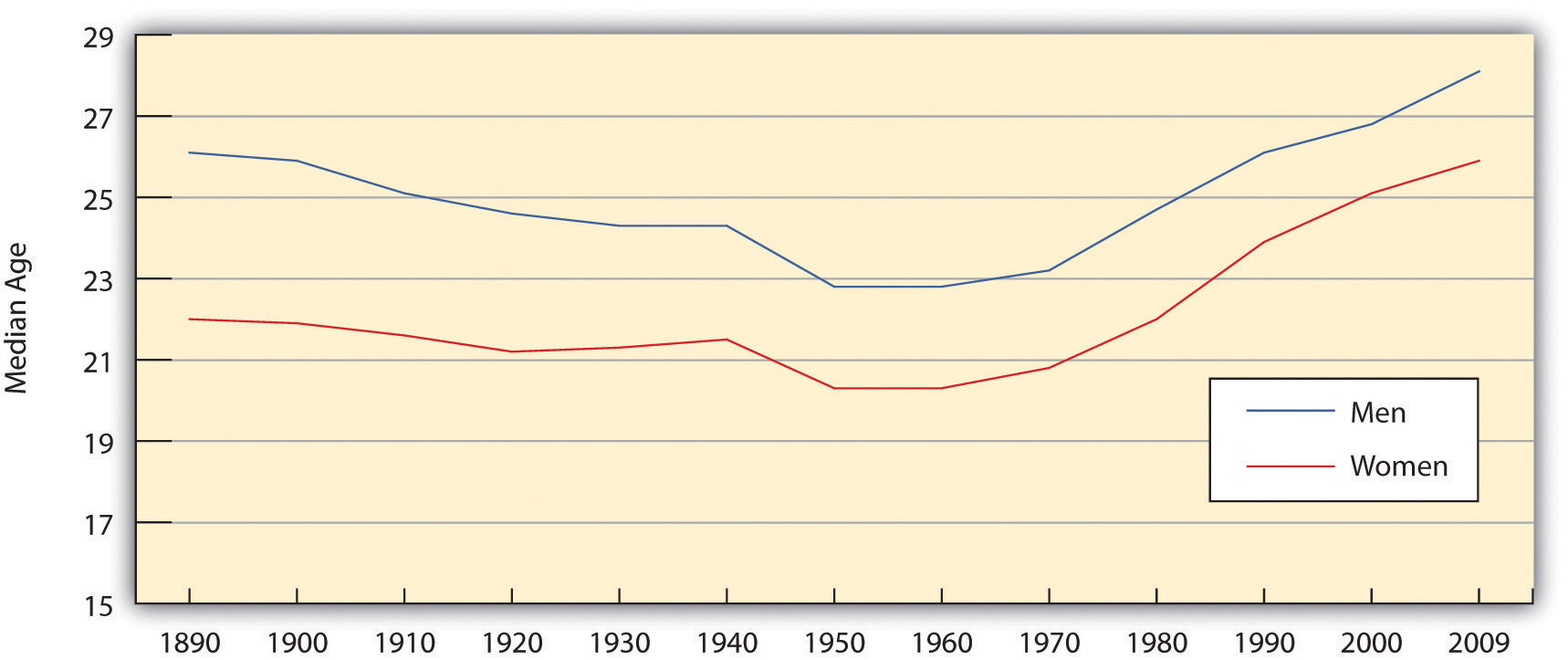
Median Age at First Marriage, 1890–2010
The following table shows the median age of men and women when they were first married in the United States from 1890 to 2010. The median age for a man's first marriage was 28.2 years in 2010, up from 26.1 in 1990. The median age for a woman's first marriage was 26.1 years in 2010, up from 23.9 in 1990.
| Year | Males | Females |
|---|---|---|
| 1890 | 26.1 | 22.0 |
| 1900 | 25.9 | 21.9 |
| 1910 | 25.1 | 21.6 |
| 1920 | 24.6 | 21.2 |
| 1930 | 24.3 | 21.3 |
| 1940 | 24.3 | 21.5 |
| 1950 | 22.8 | 20.3 |
| 1960 | 22.8 | 20.3 |
| 1970 | 23.2 | 20.8 |
| 1980 | 24.7 | 22.0 |
| 1990 | 26.1 | 23.9 |
| 1993 | 26.5 | 24.5 |
| 1994 | 26.7 | 24.5 |
| 1995 | 26.9 | 24.5 |
| 1996 | 27.1 | 24.8 |
| 1997 | 26.8 | 25.0 |
| 1998 | 26.7 | 25.0 |
| 1999 | 26.9 | 25.1 |
| 2000 | 26.8 | 25.1 |
| 2001 | 26.9 | 25.1 |
| 2002 | 26.9 | 25.3 |
| 2003 | 27.1 | 25.3 |
| 2005 | 27.0 | 25.5 |
| 2006 | 27.5 | 25.9 |
| 2007 | 27.71 | 26.0 |
| 2008 | 27.6 | 25.9 |
| 2009 | 28.1 | 25.9 |
| 2010 | 28.2 | 26.1 |
1. The margin of error for 2007 is +/- 0.2 years. Source: U.S. Bureau of the Census; Web: www.census.gov.
In many ways, the United States differs from other Western democracies in its view of marriage and in its behavior involving marriage and other intimate relationships (Cherlin, 2010; Hull, Meier, & Ortyl, 2010).Cherlin, A. J. (2010). The marriage-go-round: The state of marriage and the family in America today. New York, NY: Vintage; Hull, K. E., Meier, A., & Ortyl, T. (2010). The changing landscape of love and marriage. Contexts, 9(2), 32–37. First, Americans place more emphasis than their Western counterparts on the ideal of romantic love as a basis for marriage and other intimate relationships and on the cultural importance of marriage. Second, the United States has higher rates of marriage than other Western nations. Third, the United States also has higher rates of divorce than other Western nations; for example, 42% of American marriages end in divorce after 15 years, compared to only 8% in Italy and Spain. Fourth, Americans are much more likely than other Western citizens to remarry once they are divorced, to cohabit in short-term relationships, and, in general, to move from one intimate relationship to another, a practice called serial monogamy. This practice leads to instability that can have negative impacts on any children that may be involved and also on the adults involved.
The U.S. emphasis on romantic love helps account for its high rates of marriage, divorce, and serial monogamy. It leads people to want to be in an intimate relationship, marital or cohabiting. Then, when couples get married because they are in love, many quickly find that passionate romantic love can quickly fade; because their expectations of romantic love were so high, they become more disenchanted once this happens and unhappy in their marriage. The American emphasis on independence and individualism also makes divorce more likely than in other nations; if a marriage is not good for us, we do what is best for us as individuals and end the marriage. As Andrew J. Cherlin (2010, p. 4)Cherlin, A. J. (2010). The marriage-go-round: The state of marriage and the family in America today. New York, NY: Vintage. observes, “Americans are conflicted about lifelong marriage: they value the stability and security of marriage, but they tend to believe that individuals who are unhappy with their marriages should be allowed to end them.” Still, the ideal of romantic love persists even after divorce, leading to remarriage and/or other intimate relationships.
For further information http://pewrsr.ch/1hjisPB Article 5 Facts About Love and Marriage
Families and Children in the United States
The United States has about 36 million families with children under 18. About 70% of these are married-couple families, while 30% (up from about 14% in the 1950s) are one-parent families. Most of these latter families are headed by the mother (see Figure 12.2.4 "Family Households With Children Under 18 Years of Age, 2008").
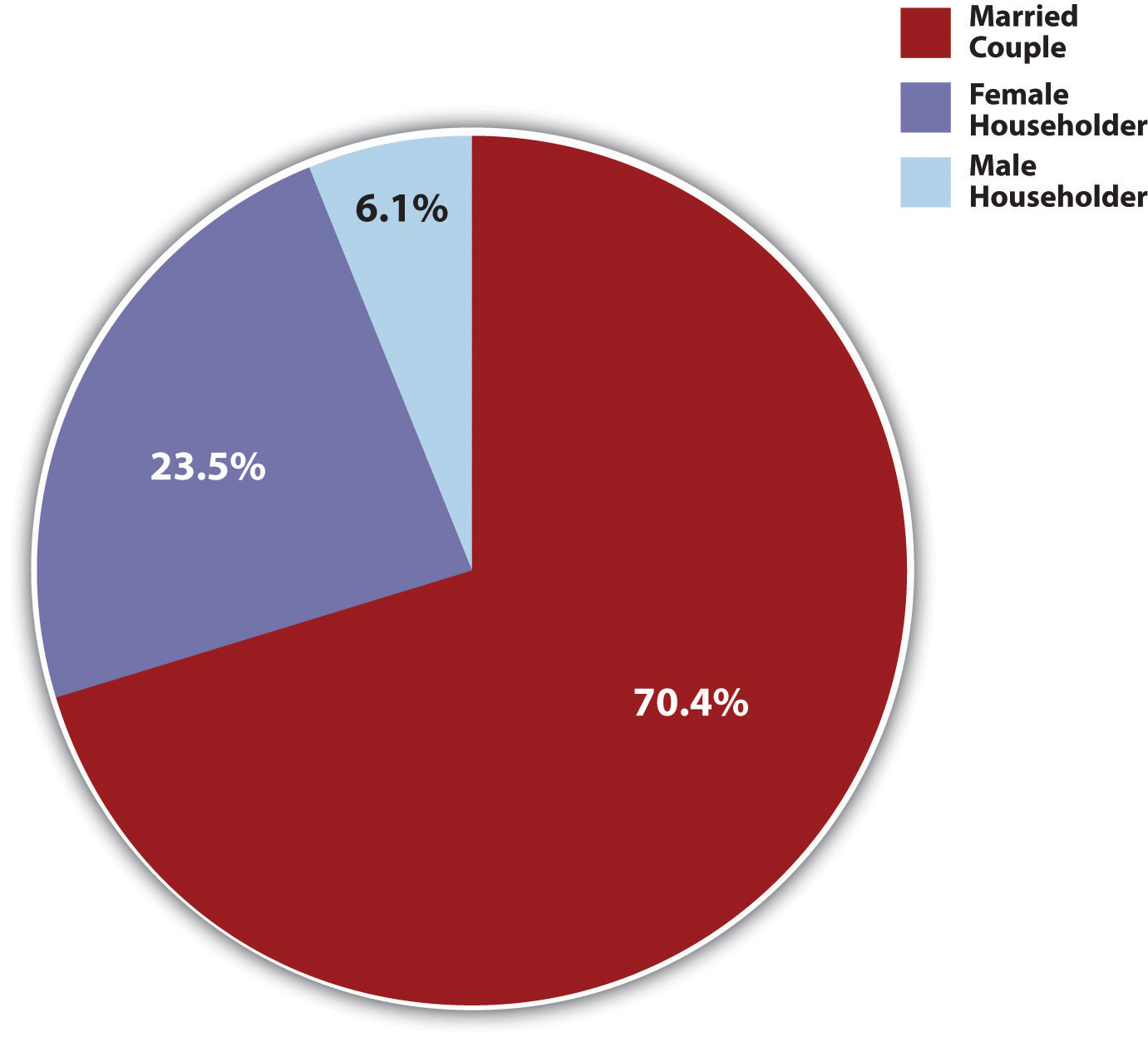
The proportion of families with children under 18 that have only one parent varies significantly by race and ethnicity: Latino and African American families are more likely than white and Asian American households to have only one parent (see Figure 12.2.5 "Race, Ethnicity, and Percentage of Family Groups With Only One Parent, 2008"). Similarly, whereas 30% of all children do not live with both their biological parents, this figure, too, varies by race and ethnicity: 22% for non-Latino white children, compared to 15% of Asian children, 30% of Latino children, and 62.5% of African American children.
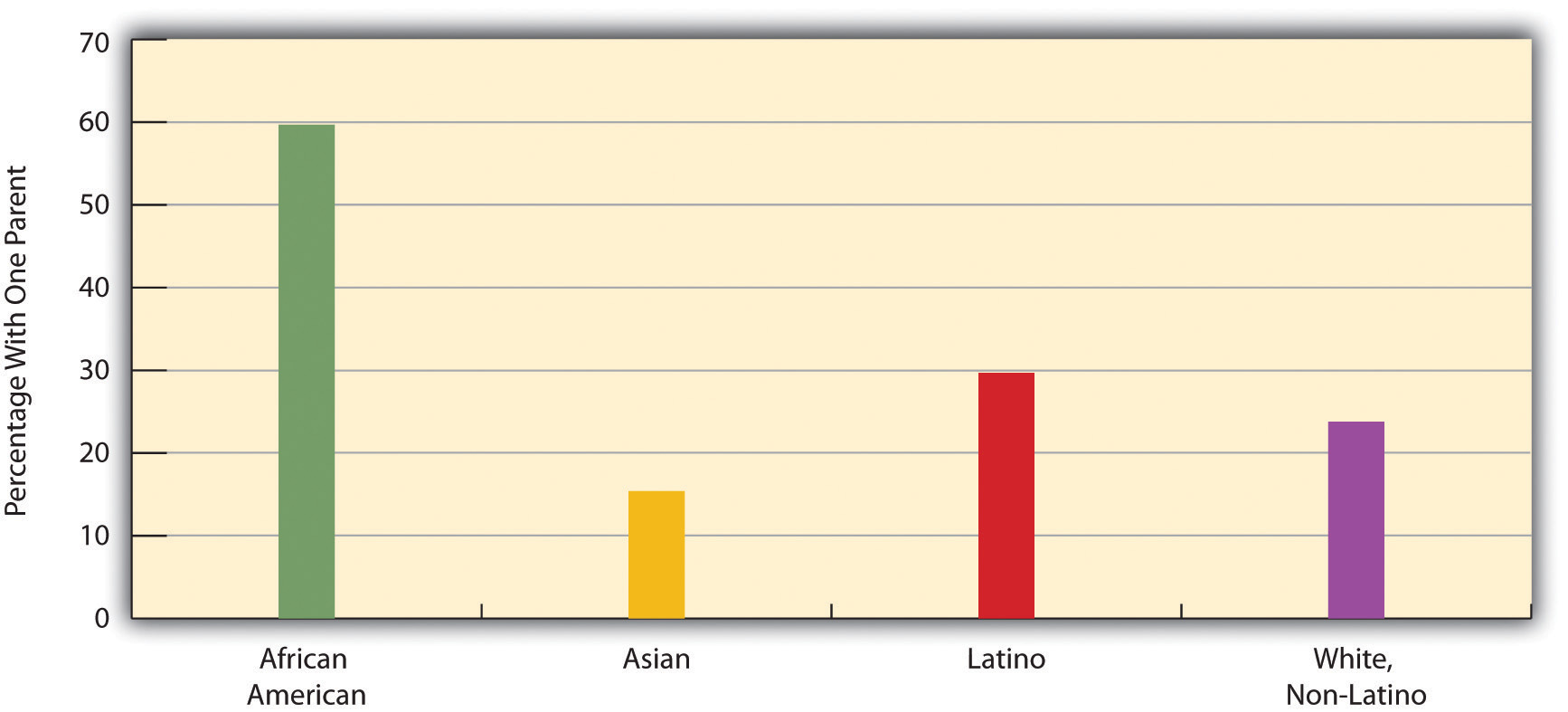
It is worth noting that children, despite all the joy and fulfillment they so often bring to parents, also tend to reduce parents’ emotional well-being. As a recent review summarized the evidence, “Parents in the United States experience depression and emotional distress more often than their childless adult counterparts. Parents of young children report far more depression, emotional distress and other negative emotions than non-parents, and parents of grown children have no better well-being than adults who never had children” (Simon, 2008, p. 41).Simon, R. W. (2008). The joys of parenthood, reconsidered. Contexts, 7(2), 40–45.
Children have these effects because raising them can be both stressful and expensive. Depending on household income, the average child costs parents between $134,000 and $270,000 from birth until age 18. College education obviously can cost tens of thousands of dollars beyond that. Robin W. Simon (2008)Simon, R. W. (2008). The joys of parenthood, reconsidered. Contexts, 7(2), 40–45. argues that American parents’ stress would be reduced if the government provided better and more affordable day care and after-school options, flexible work schedules, and tax credits for various parenting costs. She also thinks that the expectations Americans have of the joy of parenthood are unrealistically positive and that parental stress would be reduced if expectations became more realistic.
Changes and Issues Affecting American Families
Cohabitation
Some people who are not currently married nonetheless cohabit, or live together with someone of the opposite sex in a romantic relationship. The census reports that almost 7 million opposite-sex couples are currently cohabiting; these couples constitute about 10% of all opposite-sex couples (married plus unmarried). The average cohabitation lasts less than 2 years and ends when the couple either splits up or gets married; about half of cohabiting couples do marry, and half split up. More than half of people in their 20s and 30s have cohabited, and roughly one-fourth of this age group is currently cohabiting (Brown, 2005).Brown, S. I. (2005). How cohabitation is reshaping American families. Contexts, 4(3), 33–37. Roughly 55% of cohabiting couples have no biological children, about 45% live with a biological child of one of the partners, and 21% live with their own biological child. (These figures add to more than 100% because many couples live with their own child and a child of just one of the partners.) About 5% of children live with biological parents who are cohabiting.
Interestingly, married couples who have cohabited with each other before getting married are morelikely to divorce than married couples who did not cohabit. As Susan I. Brown (2005, p. 34)Brown, S. I. (2005). How cohabitation is reshaping American families. Contexts, 4(3), 33–37. notes, this apparent consequence is ironic: “The primary reason people cohabit is to test their relationship’s viability for marriage. Sorting out bad relationships through cohabitation is how many people think they can avoid divorce. Yet living together before marriage actually increases a couple’s risk of divorce.” Two possible reasons may account for this result. First, cohabitation may change the relationship between a couple and increase the chance they will divorce if they get married anyway. Second, individuals who are willing to live together without being married may not be very committed to the idea of marriage and thus may be more willing to divorce if they are unhappy in their eventual marriage.
The children of cohabiting parents tend to exhibit lower well-being of various types than those of married parents: they are more likely to engage in delinquency and other antisocial behavior, and they have lower academic performance and worse emotional adjustment. The reasons for these differences remain to be clarified but may again stem from the types of people who choose to cohabit rather than marry.
Divorce and Single-Parent Households
Divorce, while fairly common and accepted in modern American society, was once a word that would only be whispered and was accompanied by gestures of disapproval. In 1960, divorce was generally uncommon, affecting only 9.1 out of every 1,000 married persons. That number more than doubled (to 20.3) by 1975 and peaked in 1980 at 22.6 (Popenoe 2007). Over the last quarter century, divorce rates have dropped steadily and are now similar to those in 1970. The dramatic increase in divorce rates after the 1960s has been associated with the liberalization of divorce laws and the shift in societal make up due to women increasingly entering the workforce (Michael 1978). The decrease in divorce rates can be attributed to two probable factors: an increase in the age at which people get married, and an increased level of education among those who marry—both of which have been found to promote greater marital stability.
Divorce does not occur equally among all Americans; some segments of the American population are more likely to divorce than others. According the American Community Survey (ACS), men and women in the Northeast have the lowest rates of divorce at 7.2 and 7.5 per 1,000 people. The South has the highest rate of divorce at 10.2 for men and 11.1 for women. Divorce rates are likely higher in the South because marriage rates are higher and marriage occurs at younger-than-average ages in this region. In the Northeast, the marriage rate is lower and first marriages tend to be delayed; therefore, the divorce rate is lower (U.S. Census Bureau 2011).
The rate of divorce also varies by race. In a 2009 ACS study, American Indian and Alaskan Natives reported the highest percentages of currently divorced individuals (12.6 percent) followed by blacks (11.5 percent), whites (10.8 percent), Pacific Islanders (8 percent), Latinos (7.8 percent) and Asians (4.9 percent) (ACS 2011). In general those who marry at a later age, have a college education have lower rates of divorce.
| Year | Divorces and annulments | Population | Rate per 1,000 total population |
|---|---|---|---|
| 2009 | 840,000 | 242,497,000 | 3.5 |
| 2008 | 844,000 | 240,663,000 | 3.5 |
| 2007 | 856,000 | 238,759,000 | 3.6 |
| 2006 | 872,000 | 236,172,000 | 3.7 |
| 2005 | 847,000 | 234,114,000 | 3.6 |
| 2004 | 879,000 | 237,042,000 | 3.7 |
| 2003 | 927,000 | 245,200,000 | 3.8 |
| 2002 | 955,000 | 243,600,000 | 3.9 |
| 2001 | 940,000 | 236,650,000 | 4.0 |
| 2000 | 944,000 | 233,550,000 | 4.0 |
The U.S. divorce rate has risen since the early 1900's, with several peaks and valleys, and is now the highest in the industrial world. It rose sharply during the Great Depression and World War II, probably because of the economic distress of the former and the family disruption caused by the latter, and fell sharply after the war as the economy thrived and as marriage and family were proclaimed as patriotic ideals. It dropped a bit more during the 1950s before rising sharply through the 1960's and 1970's (Cherlin, 2009).Cherlin, A. J. (2009). The marriage-go-round: The state of marriage and the family in America today. New York, NY: Knopf. The divorce rate has since declined somewhat (see Figure 12.2.6 "Number of Divorces per 1,000 Married Women Aged 15 or Older, 1960–2008") and today is only slightly higher than its peak at the end of World War II. Still, the best estimates say that 40%–50% of all new marriages will one day end in divorce (Teachman, 2008).Teachman, J. (2008). Complex life course patterns and the risk of divorce in second marriages. Journal of Marriage & Family, 70(2), 294–305. The surprising announcement in June 2010 of the separation of former vice president Al Gore and his wife, Tipper, was a poignant reminder that divorce is a common outcome of many marriages.
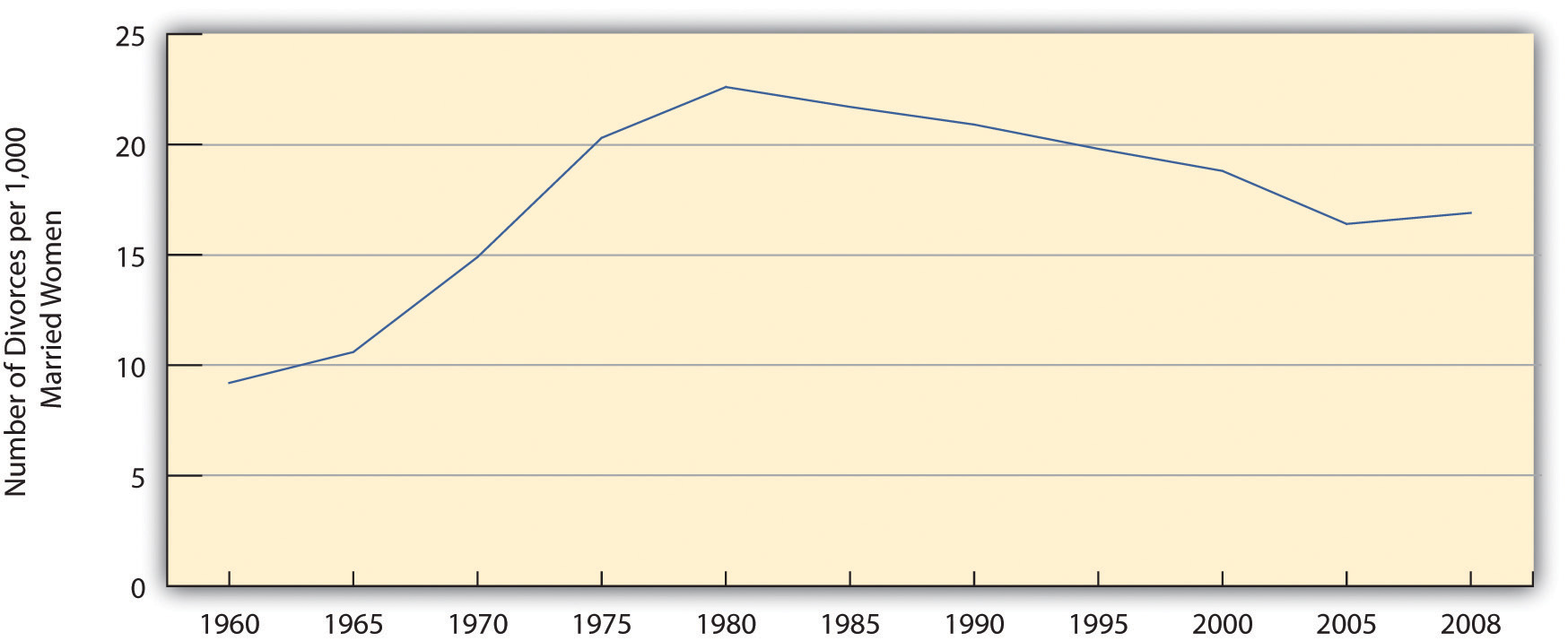
Reasons for Divorce
We cannot be certain about why the divorce rate rose so much during the 1960's and 1970's, but we can rule out two oft-cited causes. First, there is little reason to believe that marriages became any less happy during this period. We do not have good data to compare marriages then and now, but the best guess is that marital satisfaction did not decline after the 1950's ended. What did change was that people after the 1950's became more willing to seek divorces in marriages that were already unhappy.
Second, although the contemporary women’s movement is sometimes blamed for the divorce rate by making women think marriage is an oppressive institution, the trends in Figure 12.2.6 "Number of Divorces per 1,000 Married Women Aged 15 or Older, 1960–2008" suggest this blame is misplaced. The women’s movement emerged in the late 1960's and was capturing headlines by the early 1970s. Although the divorce rate obviously rose after that time, it also started rising several years before the women’s movement emerged and capturing headlines. If the divorce rate began rising before the women’s movement started, it is illogical to blame the women’s movement. Instead, other structural and cultural forces must have been at work, just as they were at other times in the last century, as just noted, when the divorce rate rose and fell.
Why, then, did divorce increase during the 1960's and 1970's? One reason is the increasing economic independence of women. As women entered the labor force in the 1960s and 1970s, they became more economically independent of their husbands, even if their jobs typically paid less than their husbands’ jobs. When women in unhappy marriages do become more economically independent, they are more able to afford to get divorced than when they have to rely entirely on their husbands’ earnings (Hiedemann, Suhomlinova, & O’Rand, 1998).Hiedemann, B., Suhomlinova, O., & O’Rand, A. M. (1998). Economic independence, economic status, and empty nest in midlife marital disruption.Journal of Marriage and the Family, 60, 219–231. When both spouses work outside the home, moreover, it is more difficult to juggle the many demands of family life, especially child care, and family life can be more stressful. Such stress can reduce marital happiness and make divorce more likely. Spouses may also have less time for each other when both are working outside the home, making it more difficult to deal with problems they may be having.
It is also true that disapproval of divorce has declined since the 1950s, even if negative views of it still remain (Cherlin, 2009).Cherlin, A. J. (2009). The origins of the ambivalent acceptance of divorce. Journal of Marriage & Family, 71(2), 226–229. Not too long ago, divorce was considered a terrible thing; now it is considered a normal if unfortunate part of life. We no longer say a bad marriage should continue for the sake of the children. When New York Governor Nelson Rockefeller ran for president in the early 1960s, the fact that he had been divorced hurt his popularity, but when California Governor Ronald Reagan ran for president less than two decades later, the fact that he had been divorced was hardly noted. But is the growing acceptability of divorce a cause of the rising divorce rate, or is it the result of the rising divorce rate? Or is it both a cause and result? This important causal order question is difficult to resolve.

Another reason divorce rose during the 1960s and 1970s may be that divorces became easier to obtain legally. In the past, most states required couples to prove that one or both had committed actions such as mental cruelty, adultery, or other such behaviors in order to get divorced. Today almost all states have no-fault divorce laws that allow a couple to divorce if they say their marriage has failed from irreconcilable differences. Because divorce has become easier and less expensive to obtain, more divorces occur. But are no-fault divorce laws a cause or result of the post-1950s rise in the divorce rate? The divorce rate increase preceded the establishment of most states’ no-fault laws, but it is probably also true that the laws helped make additional divorces more possible. Thus no-fault divorce laws are probably one reason for the rising divorce rate after the 1950s, but only one reason (Kneip & Bauer, 2009).Kneip, T., & Bauer, G. (2009). Did unilateral divorce laws raise divorce rates in Western Europe?Journal of Marriage & Family, 71(3), 592–607.
We have just looked at possible reasons for divorce rate trends, but we can also examine the reasons why certain marriages are more or less likely to end in divorce within a given time period. Although, as noted earlier, 40%–50% of all new marriages will probably end in divorce, it is also true that some marriages are more likely to end than others. Family scholars identify several correlates of divorce (Clarke-Stewart & Brentano, 2006; Wilcox, 2009).Clarke-Stewart, A., & Brentano, C. (2006). Divorce: Causes and consequences. New Haven, CT: Yale University Press; Wilcox, W. B. (Ed.). (2009). The state of our unions, 2009: Marriage in America. Charlottesville: The National Marriage Project, University of Virginia. An important one is age at marriage: teenagers who get married are much more likely to get divorced than people who marry well into their 20s or beyond, partly because they have financial difficulties and are not yet emotionally mature. A second correlate of divorce is social class: people who are poor at the time of their marriage are more likely to get divorced than people who begin their marriages in economic comfort, as the stress of poverty causes stress in marriage. Divorce is thus another negative life chance of people at the bottom of the socioeconomic ladder.
Effects of Divorce and Single-Parent Households
Much research exists on the effects of divorce on spouses and their children, and scholars do not always agree on what these effects are. One thing is clear: divorce plunges many women into poverty or near-poverty (Gadalla, 2008).Gadalla, T. M. (2008). Gender differences in poverty rates after marital dissolution: A longitudinal study. Journal of Divorce & Remarriage, 49(3/4), 225–238. Many have been working only part time or not at all outside the home, and divorce takes away their husband’s economic support. Even women working full time often have trouble making ends meet, because, as we saw in earlier chapters, so many are in low-paying jobs. One-parent families headed by a woman for any reason are much poorer ($30,296 in 2008 median annual income) than those headed by a man ($44,358). Meanwhile, the median income of married-couple families is much higher ($72,589). Almost 30% of all single-parent families headed by women are officially poor.
Although the economic consequences of divorce seem clear, what are the psychological consequences for husbands, wives, and their children? Are they better off if a divorce occurs, worse off, or about the same? The research evidence is very conflicting. Many studies find that divorced spouses are, on average, less happy and have poorer mental health after their divorce, but some studies find that happiness and mental health often improve after divorce (Williams, 2003; Waite, Luo, & Lewin, 2009).Williams, K. (2003). Has the future of marriage arrived? A contemporary examination of gender, marriage, and psychological well-being. Journal of Health & Social Behavior, 44, 470–487; Waite, L. J., Luo, Y., & Lewin, A. C. (2009). Marital happiness and marital stability: Consequences for psychological well-being. Social Science Research, 38(1), 201–212. The post-divorce time period that is studied may affect what results are found: for some people psychological well-being may decline in the immediate aftermath of a divorce, given how difficult the divorce process often is, but rise over the next few years. The contentiousness of the marriage may also matter. Some marriages ending in divorce have been filled with hostility, conflict, and sometimes violence, while other marriages ending in divorce have not been very contentious at all, even if they have failed. Individuals seem to fare better psychologically after ending a very contentious marriage but fare worse after ending a less contentious marriage (Amato & Hohmann-Marriott, 2007).Amato, P. R., & Hohmann-Marriott, B. (2007). A comparison of high- and low-distress marriages that end in divorce. Journal of Marriage & Family, 69(3), 621–638.
What about the children? Parents used to stay together “for the sake of the children,” thinking that divorce would cause their children more harm than good. Studies of this issue generally find that children in divorced families are indeed more likely, on average, to do worse in school, to use drugs and alcohol and suffer other behavioral problems, and to experience emotional distress and other psychological problems (Sun & Li, 2009; Amato & Cheadle, 2008).Sun, Y., & Li, Y. (2009). Parental divorce, sibship size, family resources, and children’s academic performance. Social Science Research, 38(3), 622–634; Amato, P. R., & Cheadle, J. E. (2008). Parental divorce, marital conflict and children’s behavior problems: A comparison of adopted and biological children. Social Forces, 86(3), 1139–1161.
However, it is sometimes difficult in these studies to determine whether the effects on children stem from the divorce itself or, instead, from the parental conflict that led to the divorce. This problem raises the possibility that children may fare better if their parents end a troubled marriage than if their parents stay married. The evidence on this issue generally mirrors the evidence for spouses just cited: children generally fare better if their parents end a highly contentious marriage, but they fare worse if their parents end a marriage that has not been highly contentious (Booth & Amato, 2001; Hull, Meier, & Ortyl, 2010).Booth, A., & Amato, P. R. (2001). Parental predivorce relations and offspring postdivorce well-being. Journal of Marriage & Family, 63(1), 197; Hull, K. E., Meier, A., & Ortyl, T. (2010). The changing landscape of love and marriage. Contexts, 9(2), 32–37.
Remarriage
People in a second marriage account for approximately 19.3 percent of all married persons, and those who have been married three or more times account for 5.2 percent (U.S. Census Bureau 2011). The vast majority (91 percent) of remarriages occur after divorce; only 9 percent occur after death of a spouse (Kreider 2006). Most men and women remarry within five years of a divorce, with the median length for men (three years) being lower than for women (4.4 years). This length of time has been fairly consistent since the 1950s. The majority of those who remarry are between the ages of 25 and 44 (Kreider 2006). The general pattern of remarriage also shows that whites are more likely to remarry than black Americans.
Marriage the second time around (or third or fourth) can be a very different process than the first. Remarriage lacks many of the classic courtship rituals of a first marriage. In a second marriage, individuals are less likely to deal with issues like parental approval, premarital sex, or desired family size (Elliot 2010). In a survey of households formed by remarriage, a mere 8 percent included only biological children of the remarried couple. Of the 49 percent of homes that include children, 24 percent included only the woman’s biological children, 3 percent included only the man’s biological children, and 9 percent included a combination of both spouse’s children (U.S. Census Bureau 2006).
Marriage and Well-Being
Is marriage good for people? This is the flip side of the question addressed earlier on whether divorce is bad for people. Are people better off if they get married in the first place? Or are they better off if they stay single?
In 1972, sociologist Jessie Bernard (1972)Bernard, J. (1972). The future of marriage. New York, NY: Bantam. famously said that every marriage includes a “her marriage” and a “his marriage.” By this she meant that husbands and wives view and define their marriages differently. When spouses from the same marriage are interviewed, they disagree on such things as how often they should have sex, how often they actually do have sex, and who does various household tasks. Women do most of the housework and child care, while men are freer to work and do other things outside the home. Citing various studies, she said that marriage is better for men than for women. Married women, she said, have poorer mental health and other aspects of psychological well-being than unmarried women, while married men have better psychological well-being than unmarried men. In short, marriage was good for men but bad for women.
Critics later said that Bernard misinterpreted her data on women and that married women are also better off than unmarried women (Glenn, 1997).Glenn, N. D. (1997). A critique of twenty family and marriage and the family textbooks. Family Relations, 46, 197–208. Contemporary research generally finds that marriage does benefit both sexes: married people, women and men alike, are generally happier than unmarried people (whether never married, divorced, or widowed), score better on other measures of psychological well-being, are physically healthier, have better sex lives, and have lower death rates (Williams, 2003; Waite, Luo, & Lewin, 2009).Williams, K. (2003). Has the future of marriage arrived? A contemporary examination of gender, marriage, and psychological well-being. Journal of Health & Social Behavior, 44, 470–487; Waite, L. J., Luo, Y., & Lewin, A. C. (2009). Marital happiness and marital stability: Consequences for psychological well-being. Social Science Research, 38(1), 201–212. There is even evidence that marriage helps keep men from committing crime (Laub, 2004).Laub, J. H. (2004). The life course of criminology in the United States: The American Society of Criminology 2003 presidential address. Criminology, 42, 1–26. Marriage has these benefits for several reasons, including the emotional and practical support spouses give each other, their greater financial resources compared to those of unmarried people, and the sense of obligation that spouses have toward each other.

Three issues qualify the general conclusion that marriage is beneficial. First, it would be more accurate to say that good marriages are beneficial, because bad marriages certainly are not (Frech & Williams, 2007).Frech, A., & Williams, K. (2007). Depression and the psychological benefits of entering marriage. Journal of Health and Social Behavior, 48, 149–163. Second, although marriage is generally beneficial, its benefits seem greater for older adults than for younger adults, for whites than for African Americans, and for individuals who were psychologically depressed before marriage than for those who were not depressed (Frech & Williams, 2007).Frech, A., & Williams, K. (2007). Depression and the psychological benefits of entering marriage. Journal of Health and Social Behavior, 48, 149–163.Third, psychologically happy and healthy people may be the ones who get married in the first place and are less apt to get divorced once they do marry. If so, then marriage does not promote psychological well-being; rather, psychological well-being promotes marriage. Research testing this selectivity hypothesis finds that both processes occur: psychologically healthy people are more apt to get and stay married, but marriage also promotes psychological well-being.
For further information on the benefits of marriage, the following article Married vs Single: What Science Says is Better For Your Health can be read http://www.medicaldaily.com/married-vs-single-what-science-says-better-your-health-327878

